Click here to learn more about the How to Identify article series.
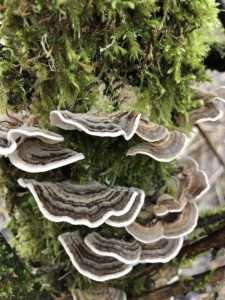 Name: Turkey Tail Mushroom (Trametes versicolor, syn. Coriolus versicolor and Polyporus versicolor)
Name: Turkey Tail Mushroom (Trametes versicolor, syn. Coriolus versicolor and Polyporus versicolor)
Range and typical habitat(s): Commonly found throughout North America, but found in varying amounts on all continents except Antarctica
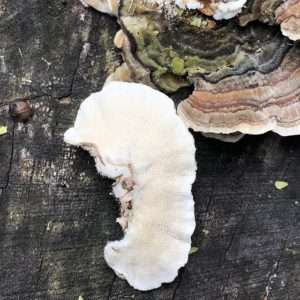
Distinguishing physical characteristics (size, colors, overall shapes, detail shapes): Turkey tail is one of a number of small, shelf-shaped mushrooms that grow on decaying wood. Most specimens are only a couple of inches across, though remarkable examples may reach eight inches across. The cap lacks a stipe (stem), and is often semicircular in shape with a ruffled edge. Like a turkey’s tail, it has several concentric bands of color, usually various shades of brown, and the center being darkest, though individual coloration may vary. Some bands may acquire a greenish tint if algae grows on them. The outermost band, which is actively growing, is white. Close examination may reveal very fine hairs on some parts of the cap. The hymenophore on the underside has very tiny pores and is usually white to pale brown.
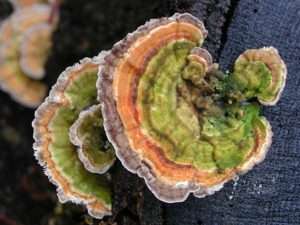 Turkey tail usually grows in big, layered clusters; some particularly large flushes may have hundreds of individual mushrooms. It only grows on the dead wood of deciduous trees. As it decays the lignin (and, to a lesser degree, cellulose) in the wood, it is included among the white-rot fungi. While many mushrooms only last a few days to a couple of weeks, turkey tails may persist for months.
Turkey tail usually grows in big, layered clusters; some particularly large flushes may have hundreds of individual mushrooms. It only grows on the dead wood of deciduous trees. As it decays the lignin (and, to a lesser degree, cellulose) in the wood, it is included among the white-rot fungi. While many mushrooms only last a few days to a couple of weeks, turkey tails may persist for months.
Other organisms it could be confused with and how to tell the difference: There are several shelf-like mushrooms that are quite similar to turkey tail. Let’s look at a few of the more common ones.
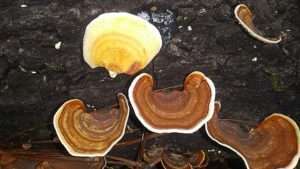
False turkey tail (Stereum ostrea) at first glance looks very similar, with its varied rings of brown and pale outer edge. However, a look at the underside reveals a smooth surface rather than the pores of true turkey tail. It also tends to be more reddish in tone and lighter overall, lacking the dark center often seen in turkey tail.
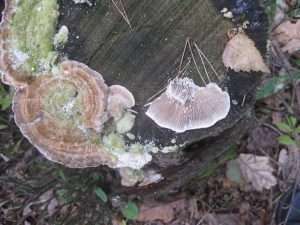
The gilled polypore (Trametes betulina, formerly Lenzites betulina) looks rather like an old, pale, washed-out turkey tail. As its common name suggests, though, it has gills instead of pores underneath the cap.
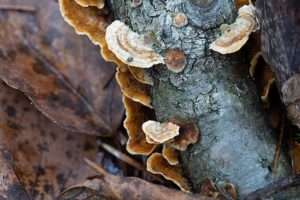
There are other Trametes species that do have pores like turkey tail does; ochre bracket (Trametes ochracea) is one example. In this case, careful examination of the coloration of prime specimens will reveal paler colors on average.
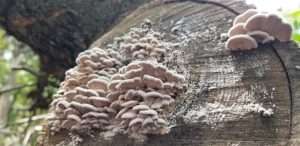
Splitgill mushrooms (Schizophylum commune) may superficially look like turkey tails at first glance, but upon examination the more uniformly pale upper cap and deeply grooved gills underneath give it away as another species entirely.
Anything else worth mentioning? While turkey tail mushrooms are not generally considered to be edible, they may be an organic substitute for chewing gum. They also have purported medicinal value. Japan allows its compound, Polysaccharide-K, as a supplementary treatment for cancer; it is also taken as a dietary supplement elsewhere. Studies regarding PSK’s efficacy in treating cancer, immune deficiencies, or other ailments are contradictory at best. While long-term use does not seem to have any particularly toxic effects, it is not recommended for pregnant people, and taking turkey tail can cause darkened stool and fingernails, and diarrhea.
As with any supplement that has not received FDA approval, caution is advised, as is speaking with your physician prior to use. The fad associated with recent Western use often skirts the line of pseudoscience, and most of the websites I found about this species were people selling it while exaggerating potential effects regarding things like gut health and general immune responses. While turkey tail is a common mushroom, overharvesting in an area can reduce the availability of spores and potentially hinder the fungus’ reproduction there.
Further reading:
Mushroom Expert: Trametes versicolor
Midwest Mycology: Trametes versicolor
Encyclopedia of Life: Turkey Tail
